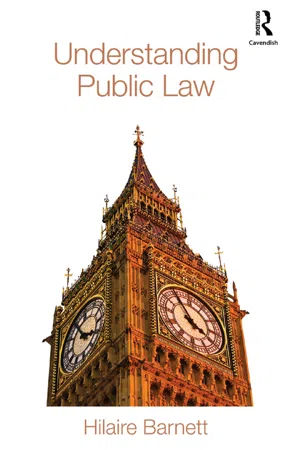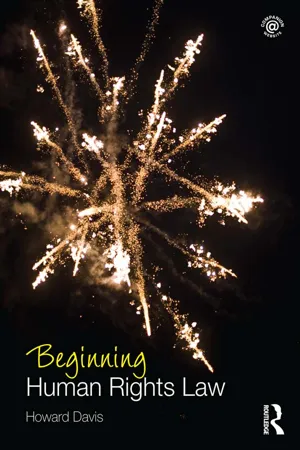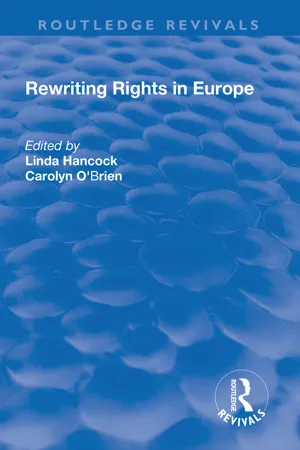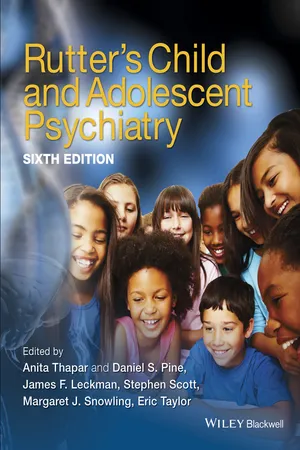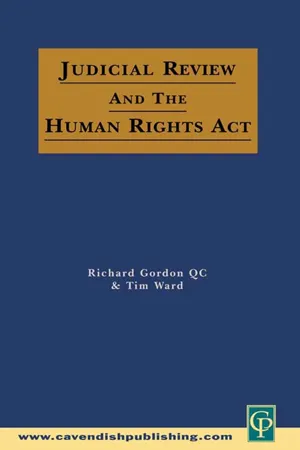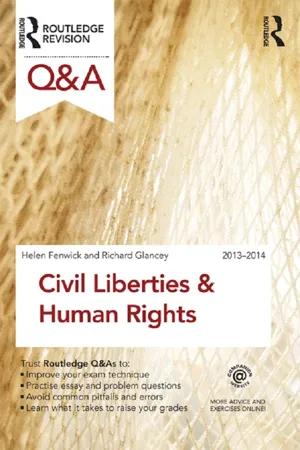Law
European Convention on Human Rights
The European Convention on Human Rights is an international treaty that protects fundamental rights and freedoms in Europe. It was established by the Council of Europe in 1950 and is enforced by the European Court of Human Rights. The convention sets out a range of civil and political rights, including the right to life, freedom of expression, and the prohibition of torture.
Written by Perlego with AI-assistance
Related key terms
9 Key excerpts on "European Convention on Human Rights"
- eBook - ePub
- Hilaire Barnett(Author)
- 2009(Publication Date)
- Routledge-Cavendish(Publisher)
The Parliamentary Assembly of the Council of Europe elects judges to office, by a majority vote cast from a list of three candidates nominated by the High Contracting Party. Judges are elected for a renewable six-year term of office.The European Convention on Human Rights and Fundamental Freedoms
The European Convention on Human Rights (the ECHR) protects civil and political (as opposed to economic and social) rights. Some of these rights are absolute, others are subject to restrictions on various grounds. The rights protected are:Article 1 imposes a duty on ‘High Contracting Parties’ to protect the Convention rights of everyone within their jurisdiction; Article 2 provides the right to life; Article 3 is an absolute prohibition against torture, inhuman or degrading treatment; Article 4 prohibits slavery and forced labour; Article 5 provides the right to liberty and security of the person; Article 6 provides the right to fair trial; Article 7 prohibits the retrospective imposition of criminal liability; Article 8 protects the right to private and family life; Article 9 protects freedom of thought, conscience and religion; Article 10 provides for freedom of expression; Article 11 protects the right to freedom of peaceful assembly and association; Article 12 protects the right to marry; Article 13 provides the right to an effective remedy for the violation of rights; Article 14 provides that there should be no discrimination in the enjoyment of the rights listed above. The impact of the Convention prior to the Human Rights Act 1998
The Convention is an agreement under international law. As such, according to British constitutional theory, the Convention could not be directly applied under domestic law without an Act of Parliament to give it effect. Accordingly, the Convention could only have influential effect. Two cases that illustrate this are:R v Secretary of State for the Home Department ex parte Brind (1991).5 In this case, the Home Secretary had exercised a discretionary power to issue a notice prohibiting the broadcasting of the voices of any person speaking on behalf of a terrorist organisation. In a challenge primarily based on the UK government’s duties under Article 10 of the Convention, the House of Lords accepted that there was a presumption that Parliament intended to comply with its obligations under international law, and to make law which complied with the Convention. However, since at the time Convention rights were not incorporated into domestic law, the House of Lords took the view that where a domestic Act of Parliament permitted two interpretations, the interpretation to be preferred was that which was in line with Convention requirements.6 - eBook - ePub
- Howard Davis(Author)
- 2014(Publication Date)
- Routledge(Publisher)
In 2013 there were 47 members of the Council. It works through a number of institutions, in particular the Committee of Ministers (made up of representatives of member state governments) and the Parliamentary Assembly (made up of representatives from the parliaments of member states). As well as human rights, it promotes its values over a wide range of areas (such as culture, education and health) and takes up world-wide causes such as the abolition of the death penalty, climate change and the protection of minorities. Unlike the EU, member states of the Coucil of Europe have not limited their sovereignty when they join. It cannot coerce its members through law. It works by persuasion and by demonstrating moral authority to the world.The European Convention for the Protection of Human Rights and Fundamental Freedoms (the European Convention on Human Rights)
The ECHR was drafted by the Council of Europe in the late 1940s and came into effect in 1953. It has been added to since then by ‘protocols’ (14 in force in 2013, with 2 more open for signature). Section (or Part) 1 of the Convention is a statement of fundamental human rights whilst sections (or Parts) 2 and 3 establish and empower the European Court of Human Rights to deal with miscellaneous issues.Under Article 1 , signatory states agree to secure the rights and freedoms listed in the Convention. States, therefore, have the primary obligation to protect human rights. They must ensure that their laws and administrative practices provide for, and are consistent with, the Convention rights. They must also ensure that adequate, legal, remedies are available in the national courts for a person whose human rights have been breached (Article 13 ). If the national courts refuse or are legally unable to provide such a remedy, the state must permit individuals or organisations to send a case to the Court of Human Rights (Article 34). Under Articles 1 - eBook - ePub
- Linda Hancock, Carolyn O'Brien(Authors)
- 2017(Publication Date)
- Routledge(Publisher)
Its stated objectives, like those of the Universal Declaration on Human Rights before it and its close cousin the International Covenant on Civil and Political Rights after it, are impressively ambitious. What is more, the Convention situates its proclamations on human rights firmly within the context of the liberal, democratic ideals of the West. 3 The Preamble to the Convention declares: Fundamental Freedoms... are the foundation of justice and peace in the world and are best maintained on the one hand by an effective political democracy and on the other by a common understanding and observance of the human rights on which they depend... In terms of the power and effect of the enforcement mechanisms of the ECHR, no other international human rights instrument bears comparison—not the American Convention on Human Rights (1969), nor the African Charter on Human and Peoples' Rights (1981) and not any of the United Nations' human rights covenants and conventions. 4 In fact, the ECHR's legal effect is aligned more closely with domestic human rights laws such as the Canadian Charter of Rights and Freedoms and the amendments to the United States Constitution that comprise its Bill of Rights, both in respect of its standing within the constituency it serves and its wider international influence. 5 Furthermore, the fact that the aspirational form of the Convention has been backed by the authority of its enforcement apparatus has been influential in the emergence of a new school of thinking in international relations and international law. The so-called cosmopolitan theorists see a defining characteristic of what is law as being based in the generic notion of human rights observance rather than by the simple, empirical recognition of the sovereignty of nation states (Gould, 1990, chapter 12; Téson, 1990, p - eBook - ePub
- Anita Thapar, Daniel Pine, James F. Leckman, Stephen Scott, Margaret J. Snowling, Eric A. Taylor(Authors)
- 2015(Publication Date)
- Wiley-Blackwell(Publisher)
Moreover, the issues engage with the human rights of both parents and child. The right to liberty and security of person, the right not to be subjected to torture or inhuman or degrading treatment or punishment, the right to physical and psychological integrity, the right to respect for family life, and the right to a fair trial have been recognized since the United Nations Universal Declaration of Human Rights in 1948, since translated into the binding International Covenants on Civil and Political Rights and Economic, Social and Cultural Rights in 1966, and supplemented by UN Conventions catering for specific groups, of which the Convention on the Rights of the Child (CRC) 1989 and the Convention on the Rights of Persons with Disabilities (CRPD) 2006 are the most relevant. In addition, members of the Council of Europe must become parties to the European Convention on Human Rights (ECHR) 1950.In common law countries, such international treaties are binding in international law once ratified, but do not generally become part of the ordinary law of the land unless the national Parliament so provides. Under the United Kingdom's Human Rights Act 1998 (HRA), the rights guaranteed by the ECHR became rights enforceable in the UK law. The UK has not legislated to incorporate the whole of the CRC or the CRPD into its domestic law; but the European Court of Human Rights in Strasbourg interprets the ECHR rights in the light of other international human rights instruments; so the CRC is increasingly finding its way into both the Strasbourg and the UK courts' judgments on children's rights issues.2 Under its influence there is further support for the general movement toward now giving young people greater rights concerning their own future while reducing the supervisory rights of their parents.3 Something similar may eventually be said of the CRPD.Most western style democracies have written constitutions which also protect fundamental rights. The oldest is the Constitution of the United States of America, with its Bill of Rights of 1791 and later Amendments. This does not explicitly protect many of the rights recognized in the Universal Declaration and other modern instruments, but a great deal has been achieved through interpretation, in particular of the “due process” and “equal protection” clauses in the 14th Amendment. The modern Constitutions of the independent Commonwealth countries protect enumerated fundamental rights which are largely based on those in the ECHR. In between are the “old” Commonwealth countries, which (apart from Australia) have their own Bill or Charter of Rights, such as the Canadian Charter of Rights and Freedoms 1982. National laws dealing with mental health issues have therefore to be judged against these constitutional standards. - eBook - ePub
The SAGE Handbook of Human Rights
Two Volume Set
- Anja Mihr, Mark Gibney(Authors)
- 2014(Publication Date)
- SAGE Publications Ltd(Publisher)
37 The European Convention on Human Rightsand the Protection of Socio-Economic DemandsIda Elisabeth KochIntroduction
It is widely held that the European Convention on Human Rights (ECHR) primarily protects civil and political rights, although the notion of positive obligations has long since been recognised in case law from the European Court of Human Rights (ECtHR). However, case law from the Court has indeed developed and today it is legally acceptable to claim that the Court also protects aspects of socio-economic rights. This development is interesting not only because it blurs the distinction between the two sets of rights but also because of the relative strength of the monitoring bodies. The Committee on Economic, Social and Cultural Rights (CESCR) and the European Committee of Social Rights (ECSR) cannot deal with individual complaints. An Optional Protocol to the Covenant on Economic, Social and Cultural Rights has been adopted, and recently entered into force (see Optional Protocol to the International Covenant on Economic, Social and Cultural Rights, 2008). The ECSR can only receive collective complaints (see Additional Protocol to the European Social Charter Providing for a System of Collective Complaints, 1995, ETS No. 158). Even if the monitoring bodies could deal with individual complaints, the effectiveness of the Court is much greater; thus, he who can link his need to one of the rights in the ECHR can obtain very strong protection. However, he who is ‘only’ hungry, homeless or sick will go in vain to the ECtHR.The reasoning behind the originally limited span of the ECHR was explained in the following way by Teitgen, who was rapporteur for the committee that prepared the first draft to the ECHR:It [the committee] considered that, for the moment, it is preferable to limit the collective guarantee to those rights and essential freedoms which are practised, after long usage and experience, in all the democratic countries. While they are the first triumph of democratic regimes, they are also the necessary condition under which they operate. Certainly, professional freedoms and social rights, which have themselves an intrinsic value, must also, in the future, be defined and protected. Everyone will, however, understand that it is necessary to begin at the beginning - eBook - ePub
- Richard Gordon, Tim Ward(Authors)
- 2013(Publication Date)
- Routledge-Cavendish(Publisher)
Chapter 7 The Convention and Community Law
DOI: 10.4324/9781843140368-7Overview
7.01 The relationship between European Community law, the European Convention on Human Rights and the Human Rights Act 1998 is complex. Three fundamental questions arise:- On what basis are the principles underlying the ECHR part of Community law?
- To what extent are these principles part of Community law?
- How should the High Court, on judicial review, approach human rights issues where Community law is involved?
7.03 First, the nature and extent of ECHR principles as part of Community law are a matter for determination by the European Court of Justice in Luxembourg (‘ECJ’) rather than the European Court of Human Rights in Strasbourg1 or, indeed, the national court. This legal reality, elementary in the context of Community law, is relevant to the general priority that the High Court must accord to the ECJ over Strasbourg where Convention issues arise in the course of a determination as to whether a breach of fundamental rights has given rise to a breach of Community law.21 As will be seen, however, the Strasbourg case law is, increasingly, referred to by the ECJ. See paras 7.14 et seq.2 This is subject to the possibility, considered below, of whether as a matter of Community law Strasbourg judgments could take precedence over those of the ECJ itself.7.04 Secondly, as shall be seen, the Court in Luxembourg has, at times, reached a different view from that taken in Strasbourg as to the interpretation of Convention rights. The ECJ applies the Convention as a tool for the interpretation of fundamental rights in Community law. The Convention itself is not a part of Community law. Thus, in a case within the scope of Community law, a finding that there has been no breach of fundamental rights does not preclude a claimant from establishing a breach of Convention rights by reliance upon the Human Rights Act. - eBook - ePub
- Helen Fenwick, Richard Glancey(Authors)
- 2013(Publication Date)
- Routledge(Publisher)
20QUESTION 45How does the European Court of Human Rights ensure that it effectively interprets and applies theConventionin a way that keeps it in touch with prevailing attitudes?How to Answer this QuestionBackground toECHRand ECtHR.Problems facing ECtHR – many different states, different values, values change over time, backlog of cases.Margin of appreciation.Living Instrument doctrine.More subsidiarity? Recent calls for reform in this area, backlog of cases, stepping on toes of sovereignty.Answer StructureAim Higher Examiners will give credit to students who appreciate the position of theECtHRand the contemporary problems that it faces.Common Pitfalls Students would struggle to do well if they only focused upon the first part of the question and described the techniques and ignored the second part of the question which asks students to consider whether the techniques are effective, which requires critical analysis.ANSWERTheEuropean Convention on Human Rights(ECHR) is an instrument of international law and is unusual inasmuch as it contains within it the mechanisms for ensuring it is complied with.Section IIof theECHRestablishes the European Court of Human Rights (ECtHR) and governs how it operates.Article 19establishes the ECtHR and states that it has been created to ensure the observance of the engagements undertaken by the signatory states in relation to the rights in theConventionand its protocols.Article 46 ECHRstates that final judgments of the ECtHR are binding upon all signatories to theConvention - Helen Fenwick, Gavin Phillipson, Alexander Williams(Authors)
- 2020(Publication Date)
- Routledge(Publisher)
The European Convention on Human Rights: Achievements, Problems and Prospects (2006).5. See pp 267–68, 301, below.6. See Chapters 17 , 19 , and in particular, Chapter 17 , pp 829–38.7. In the wake of the decision in Firth and others v UK (App nos 44784/09 etc), judgment of 14 August 2014, (below pp 302–03) the Home Secretary, Theresa May, on 13.8.14 called for Britain to withdraw from the European Convention on Human Rights. David Cameron however on 25.9.14 in a speech to the Centre for Policy Studies said that the HRA should be repealed but that at present withdrawal was not planned.8. Note that we do not comment in the text on two Articles: Article 4 prohibits slavery and forced labour, subject to very narrow exceptions in relation to forced labour. It is rarely claimed. Article 12 has also not been widely claimed. It provides that ‘Men and women of marriageable age have the right to marry and to found a family, according to the national laws governing the exercise of this right.’9. P Van Dijk and GJH Van Hoof, Theory and Practice of the European Convention on Human Rights (1998), Chapter II.10. See C Gearty, ‘The European Court of Human Rights and the Protection of Civil Liberties: An Overview’ [1993] CLJ 89.11. Cmnd 9221. All the parties to the Convention, except Switzerland, are parties to this Protocol, which came into force in 1954. See pp 301–03, below.12. Cmnd 2309. It came into force in 1968; the UK is not a party. It covers freedom of movement.13. (1983) 5 EHRR 167. It came into force in 1985. The UK is now a party to it and it is included in the Human Rights Act, Sch 1. It covers removal of the death penalty.14. (1984) 7 EHRR 1. It came into force in 1988. The UK is not a party but in 1997 the Government proposed to ratify it imminently: see the White Paper, Rights Brought Home: the Human Rights Bill- eBook - ePub
Interlocking Constitutions
Towards an Interordinal Theory of National, European and UN Law
- Luis I Gordillo(Author)
- 2012(Publication Date)
- Hart Publishing(Publisher)
Revista General de Derecho Europeo .6 For an analysis of admissibility before the ECHR, see P Dijk, GJH Hoof and AW Heringa, Theory and Practice of the European Convention on Human Rights (Martinus Nijhoff, The Hague, 1998) 108–26 and J Andriantsimbazovina (2007) (n 2) 722–41.7 In Spanish, see JA Carrillo Salcedo, El Convenio Europeo de Derechos Humanos (Tecnos, Madrid, 2003) 53–9 and A Queralt Jiménez, El Tribunal de Estrasburgo: una jurisdicción internacional para la protección de los derechos fundamentales (Tirant, Valencia, 2003) 302–17.8 App No 235/56 (Commission Decision, 10 June 1958, 2 DR 257).9 Case Austria v Italy App No 788/60 (Commission Decision, 11 January 1961, 4 DR 139), which refers to the ‘public order of Europe’.10 F Tulkens, ‘L’Union européenne devant la Cour européenne des droits de l’homme’ (2000) 12(1–2) Revue Universelle des Droits de l’Homme 50 at 51.11 Case CFDT v European Communities, alternatively: their Member States a) jointly and b) severally (CFDT) App No 8030/77 (Commission Decision, 10 July 1978, 13 DR 231).12 Before going to the Commission, the CFDT Union sought the annulment of the contested Council decision before the ECJ, but it refused to consider the case since ECSC Treaty Articles 33 and 38 did not allow the Union to lodge an appeal (only Member States of the European Commission had that possibility and Article 33 ECSC Treaty allowed only to contest Commission decisions). See Case CFDT
Learn about this page
Index pages curate the most relevant extracts from our library of academic textbooks. They’ve been created using an in-house natural language model (NLM), each adding context and meaning to key research topics.
